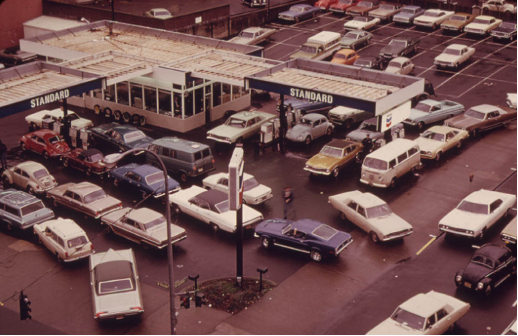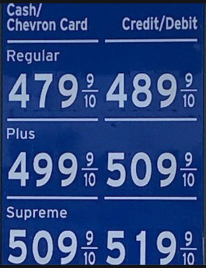For those of you who have children, every once and a while
you will hear a dirty word slip out. Back in the 70s when I was a kid, if a
dirty word slipped out, I was often treated to a little bit of a mouth washing
with a bar of soap. It was never pleasant, but it drove the lesson home. The
dirty word I want to talk about this week is not a curse or a swear word, but
it's probably even more harmful. That word is stagflation. To an economist's
ear, it is one of the worst possible words you can hear. To an actual economy,
what it describes is devastating. It's starting to be whispered about in the
dark corners of economic thought, and it will undoubtedly become part of the
national discussion soon if things do not change.
So, what does stagflation mean,
exactly? It is defined by three concurrent economic conditions—none of them
good:
- Rising prices aka inflation
- High unemployment
- A period of extended slow economic growth
There are very few outcomes that
could be worse for our country (and other countries!) than this wicked combination.
I'm going to examine all three of these conditions and try to shine some light
on where things stand. I will also examine the 1970s when we historically
suffered from this condition.

Let's go to the history first so
we can put today's developing situation into context. In 1973 the Yom Kippur
war ended, and we were faced with an oil embargo as a result. It was described
widely in the popular press as "The Oil Shock", because not only did prices
skyrocket, but there just wasn't enough gas. I wasn't driving back then, but I
am told that a good portion of many days were spent waiting in lines to get gas
when, and if, it was available. Gas prices jumped by 350% and it was subject to
rationing, such as even-odd days by license plate number.
The cost of heating oil also skyrocketed,
and people were faced with tough choices between heating their homes and buying
groceries, made even more dramatic because grocery and essentials prices were also
constantly creeping higher. Economic condition number one was fulfilled. Prices rose—a lot—and inflation was a daily
reality that everyone faced.
What about the second condition
of high unemployment? Well, the short answer is yes, it was there. In 1970 the
unemployment rate in the U.S. was roughly 3.5% and by May of 1975 it was nearly
9%. Vicious circles were involved, as rampant inflation caused producers who
were unable to raise their own prices to simply stop producing—and employing.
There was also an incredible amount of labor unrest; strikes, mass layoffs, and
supply disruptions. A grim experience if prices are going straight up and you
find yourself out of work. Condition number two was certainly in play.
A
recession is defined as a period of temporary economic decline during which
trade and industrial activity are reduced, generally identified by a fall in
GDP in two successive quarters. That is, condition number three. According to
this definition, the United States officially entered a recession in the first
quarter of 1970, exited in the 4th quarter of 1970, and then
re-entered a recessionary phase in the fourth quarter of 1973. It finally
exited that recession at the end of 1975. So, the third condition occurred off
and on for nearly 6 years in the 1970's. Output was depressed, and people were
suffering.
As I have mentioned in past posts,
there is almost never just one cause or effect behind major trends. We could tie the inflation, unemployment, and
decreased output all together in one tidy package, and when economists do this,
they label it stagflation. Each of these forces can cause the other two to be
exacerbated, and that is precisely why stagflation is so abhorred.
Ok, enough history, what about today?
Let's examine the three conditions today. As always, history never repeats
itself exactly, but as Mark Twain said, "It often rhymes." It is important as
we review these conditions that we spot all interconnectedness between them in
the evidence.
Condition #1 - Inflation.

I think it is hard to argue that we are not currently experiencing some significant inflationary pressures. Much of this "rhymes" very closely with the 1970's experience described above, but this time, it is mostly self-inflicted. As recently as last year we had achieved a level of energy independence not seen for decades. Wrangling and mismanagement have unfortunately caused this situation to reverse itself, and we are now again reliant upon OPEC+ to increase production and hopefully keep prices down, and so far, they aren't cooperating. Just this week gas prices in California set new records, at just over $5.00 per gallon. Some of this is made up of taxes and environmental charges, but to the average driver that doesn't really matter. Keep in mind these prices were just over $3.00 twelve months back. That's over a 60% increase, in one year. No rationing…yet!
All kinds of other consumer goods
prices, including for groceries, are also on the rise. I discussed the
inflation problems in my recent post "The Gates
Have Been Strained" in late October. Generally, I don't think I
will get much pushback if I say condition number one is present today.
Condition #2 - High Unemployment.
This one is a little tricky because we
are faced with a very unusual situation. At the end of October, there were
roughly 10.44 million job openings in the United States. This is up from just
over five million openings in the third quarter of 2020. The talking heads are
calling it the Great Resignation because there are about 7.4 million unemployed
people. It's a very strange imbalance and is different from the 1970s. In the
70s, producers stopped producing because the prices of inputs were outstripping
their ability to raise prices on their finished goods. It was, for the most
part, a manufacturing problem. Today, we are faced with supply chain
disruptions, high oil prices, and a labor force that is demanding much higher
wages (and sometimes bonuses) just to start. In addition, new hires are
quitting at the first sign of a better option. Of course, this labor situation
does tie into the inflation problem discussed above. So maybe this is one of
those stretch, avante garde kind of rhymes with the 70s world: not a
"cat and the hat" rhyme but maybe a "large and the cards" sort-of rhyme. I
think although not the same, condition number two, version two, is in play.
Condition #3 - Slow Economic Growth.
Once again, we are living in strange
times. The pandemic has caused all kinds of dislocations (a tie into #2), and
most economists thought we would emerge from the lockdowns at a brisk pace.
That hasn't really happened. Many downtown office buildings across the country
still sit empty. Many people are enjoying not commuting and have
semi-permanently established their workspace inside their homes. The supply chain disruptions I have talked
about many times in the past have cleared slowed output (like just try to buy a
car). At the same time, people want to travel, dine out, go to shows and
sporting events. So, there is an
incredible push and pull on the economic front. Normally, we would see
recessions arise from a lack of demand, but consumers and companies have plenty
of ready cash, so if a recession were to come in 2022 or 2023 it would probably
be driven by the supply side of the equation. If that's true, this can be avoided
if the supply chain issues can work themselves out in time. So, condition number
three? Let's say it's on the watch list.
So, my conclusion is we don't need to
wash out the economists' mouths with soap—yet! We are walking a tight rope
between stagflation and recovery, and that is a dangerous place to be, but not
an inescapable one—as I said, yet.
Final, final thought: Thanksgiving is a week away. Eat less now so you can fully enjoy all of your meal.
Fill out the form below to subscribe to my weekly blog.
The information, analysis, guidance and opinions expressed herein are for general and educational purposes only and are not intended to constitute legal, tax, securities or investment advice or a recommended course of action in any given situation. Information obtained from third party resources are believed to be reliable but not guaranteed. All opinions and views constitute our judgments as of the date of writing and are subject to change at any time without notice.


